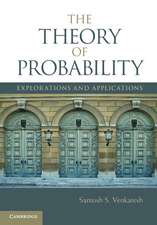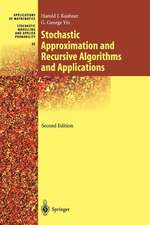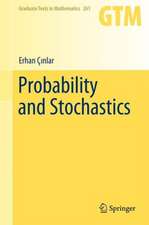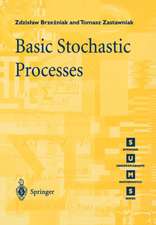Quantum Theory and Its Stochastic Limit
Autor Luigi Accardi, Yun Gang Lu, Igor Volovichen Limba Engleză Hardback – 7 aug 2002
Preț: 959.04 lei
Preț vechi: 1169.56 lei
-18% Nou
Puncte Express: 1439
Preț estimativ în valută:
183.52€ • 196.24$ • 153.01£
183.52€ • 196.24$ • 153.01£
Carte tipărită la comandă
Livrare economică 18 aprilie-02 mai
Preluare comenzi: 021 569.72.76
Specificații
ISBN-13: 9783540419280
ISBN-10: 3540419284
Pagini: 500
Ilustrații: XX, 474 p.
Dimensiuni: 156 x 234 x 32 mm
Greutate: 0.84 kg
Ediția:2002
Editura: Springer Berlin, Heidelberg
Colecția Springer
Locul publicării:Berlin, Heidelberg, Germany
ISBN-10: 3540419284
Pagini: 500
Ilustrații: XX, 474 p.
Dimensiuni: 156 x 234 x 32 mm
Greutate: 0.84 kg
Ediția:2002
Editura: Springer Berlin, Heidelberg
Colecția Springer
Locul publicării:Berlin, Heidelberg, Germany
Public țintă
ResearchCuprins
1. Notations and Statement of the Problem.- 2. Quantum Fields.- 3. Those Kinds of Fields We Call Noises.- 4. Open Systems.- 5. Spin—Boson Systems.- 6. Measurements and Filtering Theory.- 7. Idea of the Proof and Causal Normal Order.- 8. Chronological Product Approach to the Stochastic Limit.- 9. Functional Integral Approach to the Stochastic Limit.- 10. Low-Density Limit: The Basic Idea.- 11. Six Basic Principles of the Stochastic Limit.- 12. Particles Interacting with a Boson Field.- 13. The Anderson Model.- 14. Field—Field Interactions.- 15. Analytical Theory of Feynman Diagrams.- 16. Term-by-Term Convergence.- References.
Recenzii
"The authors have produced a very important and detailed book on the subject of the stochastic limit of quantum field theory. In particular, they formulate the stochastic limit in the framework of an algebraic central limit theory using the sort of scaling limits encountered in quantum transport phenomena. [...] The book is well written and covers many related problems [...] The audience will be mathematical and theoretical physicists. The authors are to be congratulated for showing the power and range of application of quantum probability to quantum physics." (Mathematical Reviews 2003h)
Textul de pe ultima copertă
The subject of this book is a new mathematical technique, the stochastic limit developed for solving nonlinear problems in quantum theory involving systems with infinitely many degrees of freedom (typically quantum fields or gases in the thermodynamic limit). This technique is condensed into some easily applied rules (called "stochastic golden rules") which allow to single out the dominating contributions to the dynamical evolution of systems in regimes involving long times and small effects. In the stochastic limit the original Hamiltonian theory is approximated using a new Hamiltonian theory which is singular. These singular Hamiltonians still define a unitary evolution and the new equations give much more insight into the relevant physical phenomena than the original Hamiltonian equations. Especially, one can explicitly compute multi-time correlations (e.g. photon statistics) or coherent vectors, which are beyond the reach of typical asymptotic techniques as well as deduce in the Hamiltonian framework the widely used stochastic Schrödinger equation and the master equation. This monograph is well suited as a textbook in the emerging field of stochastic limit techniques in quantum theory.
Caracteristici
The first comprehensive monograph on this important new approach to quantum physics by one of the founders of the concept of stochastic limit in quantum theory. Includes supplementary material: sn.pub/extras












